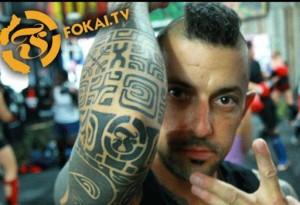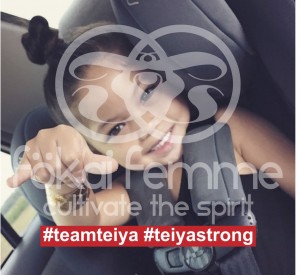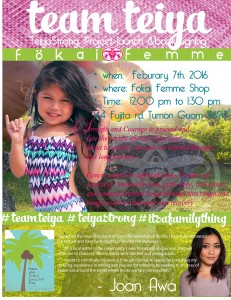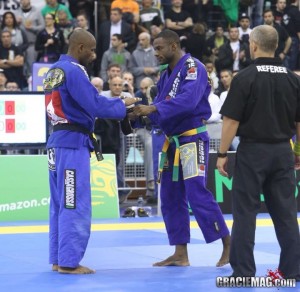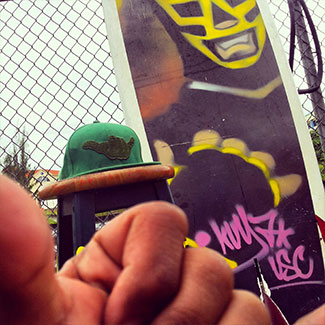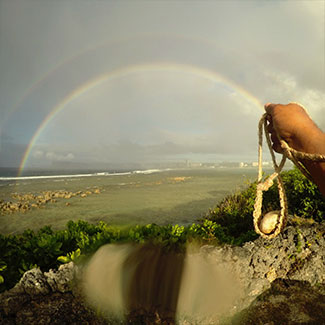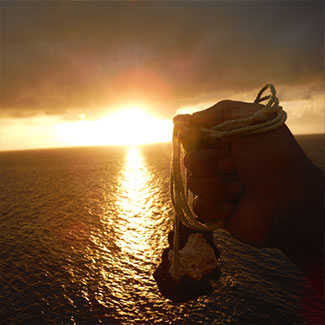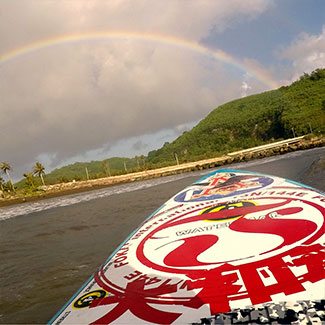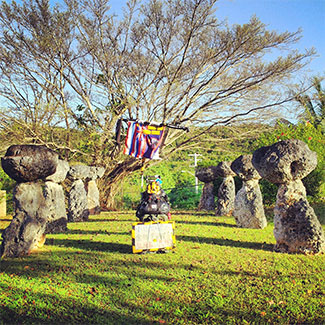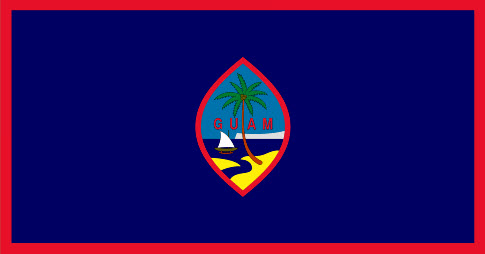FOR LIFE: SCOTTY DINGAS
Tone Anderson  feeling sad.
feeling sad.
Rest in Paradise Scotty Dingas… Now you can go where ever you want, how fast you want, popping wheelies the whole damn way, where no humans can knock you off your scoot. I know Luka and Eric got you at the gates and we will all meet again one day my brother. Journey well… I’ll miss you being here but I’ll always know you are with me.
Yo…. if you trained with or knew this dude shout him out, put him in your prayers, or tip a 40 to him. He was one of the OG SoCal Project boys and dedicated his life to Muay Thai and Motorcycles… he will always be remembered.
Love you Scotty.
–T BOOGIE ANDERSON
ABUSQUE AB AETERNO: Whats the meaning of Fokai by Pale Eric
Years ago starting Fokai Industries sent a loud and mixed vibe through the community. Friends and family knew what we were aiming to create ambitious clothing company looking to give Guam quality representation abroad but most people focused on our practice of (what was at the time ) real fight-training. this led to the misconception that fokai was the title of a fight group and that this fight group ha bad intentions. Though the foundation purpose for Fokai had nothing to do with community disservice–the English likeness of the word and the words roots in heated situations sent a controversial vibe through the community .
Pale Eric, knowing our true intentions, wrote a half page article inte Voice of the People segment on the Pacific Daily News.
after several conversations with him years later, neither of us has been able to recover that article.
The followign has been copied and pasted from his blog ellaborating on that article written about 15 years ago.
Thanks Pale. Abusque Ab Aeterno
Article by: Pale Eric
FÅKKAI
Languages change.
And it doesn’t always take outside forces to make a language change. Many changes are from within.
One example of this is the Chamorro word fåkkai.
For many years in the recent past, the word has been considered impolite. Older people will scold you for saying fåkkai in public conversation.
Ask an older person today what fåkkai means and they will say it means something along the lines of doing physical harm to someone; to demolish, tear apart and physically undo someone.
Yet….the grandparents of people today who consider the word fåkkai impolite in public conversation used the word without any shame or difficulty back in their day….because that older generation knew the original meaning of the word.
Case in point….Påle’ Roman Maria de Vera – a Spanish missionary priest considered more expert in the Chamorro language than many Chamorros of his own day (1915-1941). And it was Chamorro people who said that!
Påle’ Roman arrived on Guam in 1915 and immediately began learning Chamorro. And what kind of Chamorro was being spoken in 1915?
Well, suffice it to say that Padre Palomo, the first Chamorro priest, born in 1836, was still alive when Påle’ Roman arrived in 1915. Padre Palomo’s Chamorro would have been the Chamorro spoken in 1800, what he learned from his parents and grandparents. Padre Palomo was undoubtedly someone Påle’ Roman spoke Chamorro with till Palomo passed away in 1919.
Påle’ Roman published a Chamorro dictionary in 1932, but he certainly started compiling a list of Chamorro vocabulary many years before.
In that dictionary, Påle’ Roman defines fåkkai as “to distribute,” “to partition.”
One example is taken from the old Chamorro custom of dividing the catch after fishing.
“Ma fåkkai-ñaihon i sengsong ni guihan.”
“The people of the village were given a portion of the fish caught.”
So clearly was this original meaning of fåkkai in the minds of Chamorros that, in the 1920s or 1930s, Påle’ Roman used what many now consider an impolite word in one of his nobenas (devotional prayer book).
“Na’ gai fakkai yo’ nu i gråsia siha.”
“Give me a portion of graces.” Or, “Make me have a portion of graces.”
So, this is the original meaning of the word fåkkai. To distribute, to give people a portion of this or that.
So far, we’ve been dealing with facts. Now we move into speculation.
If fåkkai originally meant “to distribute portions,” then that involves the breaking apart of a whole.
The whole catch was broken down into portions in order to fåkkai the fish to the people in the village.
Perhaps this is where people formed the idea that to fåkkai is to break down, to break into parts or portions – no longer in order to distribute, but rather just to tear apart.
Thus, to fåkkai someone no longer meant to give that person his or her portion of something broken down, but rather to break apart the person him or herself.
Some people also use the word fåkkai when referring to mixing, by hand, different ingredients in cooking. This, too, is a breaking down of individual things in order to create a new thing out of the mix.
Whether we like it or not, a huge number of Chamorros have allowed the English language, not only to supplant their own language, but also to influence the way they think about their own vocabulary.
What Chamorro will not chuckle when they hear someone say, “That Mexican restaurant is good. I love their chili.” Only the younger, or highly Americanized, Chamorro, will not get the reference.
Because the Chamorro word fåkkai sounds so close to an English curse word, I believe fåkkai gained even more negativity among a new generation of Americanized Chamorros; Americanized in the sense that they let English influence the way they think even about Chamorro words that have no relation to English.
This mind set probably came about in the 1950s, and definitely by the 1960s.
Fast forward to our own times.
In the 1990s, a young man named Roman dela Cruz decided to market a brand of his own creation. It wasn’t just clothing; his brand was closely associated with martial arts on Guam and beyond.
He gave the word fåkkai a new meaning; his own. He had a spiritualized meaning in his own mind when he used the word fåkkai in his marketing.
For Roman, fåkkai represents the spirit or soul of the local people – the life force inside us that propels us to keep living and to overcome all challenges and to thrive.
I know this because I asked Roman about it. But I am putting into my own words what I think Roman means. If you want to, ask Roman yourself what he means.
I can see how he could make this connection. By the 1950s, to fåkkai someone was to tear them apart – a show of power. In Roman’s mind, fåkkai is that indomitable spirit that empowers us to handle life’s challenges. It was a new meaning. And, to symbolize how new it was (and is), he also gave the word his own unique and stylistic spelling : fökai.
Thus we see how languages change.
From “distribution” to “break apart,” with an uncomfortable similarity in sound to an English curse word, to “indomitable spirit.”
The thing is, no matter what the dictionary says, the meaning of words depends on what the community says. Even the dictionary will add new meanings to old words because the community has adopted a new meaning to old words like “gay” or “sick.” When something is good, some people call it “sick.”
And a community does not arrive instantly at an agreement what words mean.
There will still be many Chamorros who will never accept alternate meanings of the word fåkkai; not even the original meaning! For them, fåkkai will always mean only one thing…..to physically damage someone.
And, believe it or not, there are still older Chamorros, here and there, on Guam and in the CNMI, who still know the original meaning of the word.
And will Chamorro speakers ever adopt, in big numbers, Roman’s spiritual meaning of the word fåkkai? Time will tell.
One thing is for sure. His use of the word fåkkai on his shirts and other items for sale have put the word right smack in front of our faces, and has caused a negative reaction in some; bewilderment in others; and (unfortunately) apathy in others. For them, fökai is just cool. Or, is it hot?
#TeamTeiya:It’s a Family Thing
February 4, 2016 by admin
Filed under Familia, Special Forces
Teiya Camille Van Meter is an absolutely adorable 5 year old girl from Guam that in May of 2015 was diagnosed with a having a tumor in her brain. Since then her family has endured all things to get her the best care possible. Following Teiya’s events on as reported by her mother TARA VAN METER and staying connected with her father BJ ROLINSKI (a longtime friend and Fokai Amphibious Division team rider) hundreds have been inspired in following their footsteps in California to see that , even throughout this all, Teiya hasn’t missed a step to enlighten everyone around her.
Fokai Industries and Fokai Femme are proud and honored to
collaborate with Teiya in advocacy for the fight against cancer and to rise above all challenges towards the light at the end of the tunnel.
Her friends and family’s strength is iconic. Her strength through this all is legendary. The following is Teiya’s story.
Teiya Strong. It’s a Family Thing
I never in a million years thought I would be writing a blog explaining how we fought along side our daughter as she battled brain cancer. I do not consider myself a writer at all and I will try my hardest to share our story and our continued fight. This is all for you our sweet girl, thank you Teiya for teaching us everyday about strength and courage and most of all LOVE.
.
#TeamTeiya:#It’saFamilyThing
February 4, 2016 by admin
Filed under Familia, Fokai International
Fokai,The Force, & Legends: Fernando “Terere” Agusto
August 29, 2015 by admin
Filed under BJJ Stuff, Familia, FokaiCombatUNit, FokaiIreland
Photo and story from Gracie Magazine
Alan “Finfou “Do Nascimento just brought the venue to tears. After conceding the win to Fernando Tererê in their middleweight match, he handed Fernando Tererê his black belt. He later explained his actions: Fernando Tererê made what I am in Jiu-Jitsu. He taught me since the white belt. This belt, he gave one day and asked for 5 reais and I knew it he was going to buy crack. I told him then that I was going to give him back the belt when when he got back on his feet. There’s no better moment than that! I will sleep filled with joy and proud today!”
“F” is for FreestyleSessions:
February 9, 2015 by admin
Filed under Familia, SoCalProject
Heres a video edit from the Fokai SoCal Project with Cros One of Freestyle Sessions, one of the
World’s most recognized and established breakdancing / B-Boy events. Watch this breakdown as he talks about the elevation of the game, its past, present, and future, and bringing the big show to his backyard, San Diego.
Sinceeversince:PurebredJiujitsu
HEres a video interview were sharing from Sirena Mafnas. Its an interview on some good core questions with Stephen Roberto, the Head Instructor of PUREBRED JIUJITSU:Guam’s original,most qualified, and longest standing Jiujitsu Academy
1 pair (size 34) blue fight trunks
3 oval patches
3 femme tees (small)
1 femme tank (large or medium)
1 femme tote bag.
CULTIVATING THE SPIRIT: TheTruth Doesn’t Always Hurt
February 17, 2014 by admin
Filed under Familia, SoCalProject
Much respect for Brandon Vera who has been supporting us sinceeversince. Real stoked to see how friends and family from Guam have confided in Alliance MMA’s proven program. Hope and trust that the island vibe and martial arts experience may yield mutual benefits
for those and theirs. Thanks Brandon and Mabuhay Lahat!
Familia:TobyImada via asianmma.com
an interview copied and pasted from www.asianmma.com

With today’s breed of fighters, it is not often that you see a fighter with over 50 professional fights. Toby Imada (30-18) is one of those rare MMA fighters. He has been fighting professionally since 1998 and has fought some of the best the world has to offer. To many Toby came into the spotlight in 2009, as part of the inaugural Bellator tournament. To others Toby came into the spotlight in 2010 when he defeated Andy Souwer (147-14) at the S-Cup in Japan. Toby has excited the Japanese and American fans with his unique grappling and aggressive style. So it is with great pleasure that we got to interview him and we hope you enjoy!
CJ: You have been involved in Martial Arts for a long time, can you talk about how you started? What was it like being involved with the sport of MMA before it was mainstream? How has the sport changed the most, in your opinion?
TI: It all started with Judo training. That’s where I had encountered wrestlers and jujitsu practitioners. Given my competitive nature, I felt like I needed to cross train and learn their techniques to eliminate whatever advantages they had. My training and success in competition caught the attention of promoters. So when I was invited to compete in NHB matches, I was tentative, but tried it anyway. I never entered MMA to be a fighter. I was always a martial artist with a competitive spirit. Training was a way of life, or a hobby if you prefer. i would attend school, work, and train regularly. and when the opportunity came around I would compete, then go right back to my routine. It was a life style. The sport has evolved to become more than martial arts. It has become something where people prepare otherwise known as “camp”. Money, glamour, fame, even politics have become such a part of it all.
CJ: You have fought for a variety of organizations. What is it like being a journeyman/ronin? What are the advantages and disadvantages? Are there any organizations that you have been involved with that stick out in your memory?
TI: It feels like everyone hopes for me to lose and the the other guy to win. I kind of feel like I’m not wanted by anyone…hahaha but so what. I dont do this for acceptance. I do it for the previous reason. One advantage to that, which may be the only one, is that I get to go where ever I like. The down side to all that. I must always search for matches. Usually on my own. Bellator will always be memorable. However, to this date, I feel ShootBoxing has been the best to me. Every time I have been scheduled a fight, they have come through with everything they have promised, without having to remind them or fight over anything, and gone beyond.
CJ: While you have fought a lot of fights, you are probably most famous for your involvement in 2 tournaments. The Bellator Season 1 tournament and the Shoot Boxing S-cup in 2010. Do you prefer fighting in tournaments or doing individual fights? Can you talk about what it is like fighting in a tournament?
TI: I like both. Individual fights take pressure away from having to worry about the next match. You also know exactly who you will be facing, given nothing happens and the is a last minute substitution.. I also like the seriousness of tournaments. Having to display a skill level where you can go into and leave a fight taking least amount of damage as possible. There is a greater reward winning several fights as opposed to just one.
CJ: Speaking of your participation in the 2010 S-Cup, can you talk about how you got on Shoot Boxing’s radar? Did you pursue them or did they pursue you? What was your initial reaction?
TI: Getting into Scup was unintentional, if you can believe that. I had just come off of a fight and before i could get home I had been contacted by a friend asking if i would like to participate. I knew nothing of the organization. They thought I would be perfect for the rules. Apparently SB lost a fighter. Pressed for time and desperately needed to get the slot filled, somehow my name was brought up. I can imagine someone saying, “I bet Toby would take the fight..” I did. Im pleased with my wild decision.
CJ: Going into that tournament, you knew that some of the world’s best kick boxers and muay thai fighters were also entering the tournament. Names like Andy Souwer and Buakaw carry a lot of weight. How did it feel going into that tournament? Did you feel like you were representing MMA?
TI: Honestly, I hadn’t any idea who these people were or knew hardly anything about hem. Mind you I wasn’t completely sure what the ShootBoxing rules were either. I didn’t know what I was getting myself into. My main focus was to not let anyone walk right through me.

Souwer, Bovy, Umeno, Imada, Shishido, Buakaw, Saraiva, van Opstal
CJ: Can you talk about what it was like beating Andy Souwer, the multiple S-Cup Champion, in your first S-cup? What was your strategy? Is it one of the biggest wins of your career?
TI: My strategy was to be in his face and take every opportunity possible. Initially I tried to hit him from as any different angles as possible. I was very unorthodox, which may really have played a part in throwing him off. Inside fighting, causing a tie up then reacting with throws. What can I say, but smile.
CJ: You stated in a previous interview that your fight with Buakaw was the worst fight you’ve ever been in. Do you think the damage you took from earlier fights affected the fight? Would you be open to a re-match?
TI: Previous damage totally played a part in that. I was tired and feeling sore! I don’t know if anyone noticed, but I was already tired in round 3 versus Andy. Buakaw? Oh hell yes I would rematch.
CJ: How was the experience as a whole? Is there anything you would like to say about it? Any good stories?
TI: The entire experience was great. I cant imagine how it could have been any better. Every detail was memorable enough. Hanging out with Enson and being shown around. Not very many people at all know what that is like. blush…
CJ: Your tendency to go for throws and submissions mixed with your toughness have made you a fan favorite in Japan. What is that like? How are Japanese fans different from fans in the States?
TI: Really?! I didn’t know all. I thought it was my last name hahaha. Ok, well, I feel more of their compliments are genuine. I didn’t feel like they were saying what they thought i wanted to hear. I am very honored an pleased to be appreciated by such a reserved culture
CJ: Going into your fight with Satoru Suzuki, you were coming off of consecutive losses. How did you feel going into that fight, did you feel like you were fighting for your future in Shoot Boxing? During that fight, it seems like Suzuki escaped submissions and throws by collapsing to the canvas. Is this a problem in Shoot Boxing? What was your strategy going into the fight and how did it feel when you won?
TI: I was displeased with my previous performances. I got hit with a stomach infection for my fight with Andy which prevented me to recover from the weigh cut adequately. Also, I hadn’t as much time i had hoped for to prepare for such an opponent. It was all a learning process for me. I had to learn how to handle the travel, timing for training, and recovery. I had gathered my previous knowledge to prepare the best I could. Also, stepping up my training regimen. Opponents falling to the ground and grabbing on to the ropes made it a lot more difficult as well as frustrating. So I started working on counters for when they would, and was kind of hoping that they would. Falling to the ground is a problem in SB, but I now have a better understanding of the sport and the rules. SB has modified the rules slightly, to where they have become less tolerant and faster to penalize rope grabbing and falling to the ground in attempt to escape submissions, as seen when Suzuki attempted to fall to the ground when I had applied a standing guillotine.

Imada sinks in the choke
CJ: Can you talk about some of the friendships you have developed over there? Have you ever trained with any of the fighters over there?
TI: Seems I have developed a a friendship with several individuals at Caesar Gym as well as a few others. Enough to encourage me further study Japanese language. They’ve been very welcoming. Their mannerism and character has left me spellbound. Unfortunately, I have not yet had the honor to train with any. I hope to someday very soon. I would hold a seminar as a gesture of my gratitude for allowing me to train with them.
CJ: Because of your fights with Shoot Boxing, you are known amongst Japanese fighting fans. Have you received any offers to fight for an MMA organization in Japan? Would you like to fight for Pancrase, Shooto, DEEP or even One FC someday?
TI: Regrettably, I have not had any offers lately. I would be more than honored to compete in any of those organizations. As any who have witnessed, my style is anything other than boring.
CJ: I previously mentioned your participation in Bellator’s 1st season. Can you talk about that? It was during that season that your name became well known, due to your submission of the year over Jorge Masvidal. How did that effect your career? Have you and Bellator gone your separate ways now?
TI: At the time, I didn’t think the submission is would cause such a stir. I was excited to have come out victorious. Not sure if the submission is what brought me back or if it were my performances. I am no longer signed with Bellator. Don’t really know what happened there. My management at that time did something and just left me like that.
CJ: Can you talk about your future? Do you have any fights lined up?
TI: My future, well i am definitely not staying young. Just like anyone else, my time in the sport is very limited. I have relocated and have a new gym. Taking a little time to train and take complete control of myself and training. Not to sound bitter, but things got very unstable for me at my previous location. Now I would be starting from scratch, but this time Ive brought all my knowledge and experience somewhere it can be put to really really good use.
CJ: Shoot Boxing has had a couple of events this year, have they contacted you? Would you like to participate in this years S-Cup?
TI: I would absolutely participate in every possible SB match. I feel with SB I can act, speak, and display who i am most openly without someone telling me how, when, or what it is they want me to do. The Scup tournament is bi-yearly, so there would be one until next year. My answer, then, would still be ABSOLUTELY, if/when they contact me.
CJ: In your opinion, what makes a fighter?
TI: In my opinion a fighter is someone with a particular spirit. Someone that can dig deep within them-self despite failure, anguish and struggle, will not give up. Call us stubborn. Determined.
CJ: Is there anything that you want to say? To your Japanese fans? To your American Fans?
TI: Toby is still in good condition. training, healing, ever improving. Thank you for all the support, cant wait to return and put on a great show for the fans.
We at asianmma would like to thank Toby for his time and to wish him the best
Amazing:JTTorres on Grappler’sPlanet
Grapplers Planet Exclusive Interview with JT Torres
Interview by (GP King), questions and editing by Josh Sequeira (GP Bodmon)
Jonathan Torres, also known as JT, or ‘The Spiderman,’ is a first degree black belt part of team Atos, who trains and teaches in San Diego, California. Despite only being 24 years of age, JT has built a name for himself as a world class competitor, and one of the most exciting BJJ practitioners in the game today. 2013 was a major year for JT as he won a bronze medal in both the IBJJF Pan Ams, and the very prestigious ADCC Championships. However, JT’s greatest accomplishment this past year, was conquering the title of Black Belt World Champion, as he took home the gold medal in his division at the IBJJF No-Gi Worlds. We got a chance to chat with JT and ask him a variety of questions about competing, his plans, and about his striking resemblance to a Dutch celebrity. Enjoy!
GP: JT, you’re an avid competitor. What is your routine like, the day of a tournament?
JT: My routine the day of a tournament is pretty simple. First I wake up, and I weigh myself to make sure I am on weight. I follow this up with a super-hot shower, because I feel it wakes up all my muscles! Then, depending on where my weight is at, I will eat a small breakfast, which usually consists of oatmeal and fruits. After breakfast, I head over to the venue, check my weight again and then I start to warmup by going for a light run and then stretching. After a good warm-up, I put my music on, get in the zone and wait for my name to be called.
GP: Lately you have been competing at middleweight, despite having some incredible success at lightweight. Is there any particular reason for the change in weight class on occasion, and is this something you plan to do more often?
JT: I have been fighting middleweight here and there just because I am at a point where my body weight is naturally a middle weight and I wanted to test it out. To be honest, I am not sure if my move to middle weight is permanent or temporary. Over the years I have just put on more muscle and weight naturally. I actually started competing at light-featherweight as a blue belt. My body is at point where I can follow a strict diet and make light weight, or I can eat clean but just more and fight middle weight and still feel great. I think in the future I will be a middle weight permanently.
GP: This past year, you accomplished a major milestone in your career winning your first Black Belt World Title! How did it feel to accomplish such a feat at the 2013 No-Gi Worlds?
JT: Winning my first Black Belt World Title at the No-Gi Worlds this past year felt amazing! I felt like all my hard work finally paid off!! It was one of my greatest moments in life!
GP: Do you currently teach BJJ at all JT? What is your idea of an ideal class breakdown?
JT: Yes, I actually teach the Kids class at Atos San Diego. The way I break down a class is like this: 15 mins of warmups and 30-45 mins of drilling and technique and then my favorite 30-60 mins of sparring.
GP: You eat, sleep, and live BJJ, what kind of questions do lower belts typically ask you about the art, and what do you tell them?
JT: Lower Belts typically ask me, “What can I do to improve my game?” and I always answer, “You have got to have an open mind to whatever technique you come across, and I recommend you compete at least once.”
GP: Any comments on the possibility of you being related to world famous DJ and Dutch music producer Afrojack? Are you aware of the striking resemblance?
JT: Haha, I am not related to him, but no, I wasn’t aware till now! We do look like!
GP: To wrap things up JT, what are your immediate plans for this year?
JT: My immediate plans for this year are to fight in the Pan Ams and Worlds, and then after the Worlds, get some more tattoos!

